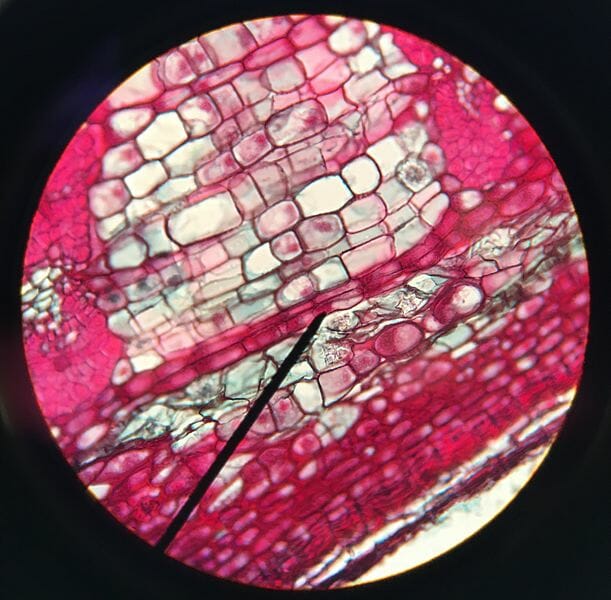Meristem is undifferentiated plant tissue found in areas of plant growth. The three types of meristematic tissue are intercalary, apical, and lateral. Apical meristem tissue is found in the tips of shoots and gives rise to leaves and flowers and is also found in the roots. The intercalary tissue in the middle of the plant is capable of rapid growth and regrowth. For example, the intercalary tissue at the base of a blade of grass allows it to regrow after being cut.
Plants use lateral meristem tissue to grow in diameter as part of secondary growth. There are two types of lateral meristematic tissue—the vascular cambium and the cork cambium.
Vascular Cambium
In plants, the vascular cambium is the main route by which the stems and roots grow. The tissue consists of xylem toward the outside and phloem inside. In woody plants, it forms a continuous ring of new wood around the stem. Herbaceous plants don’t have wood, so the vascular cambium forms bead-like bundles that create a ring around the stem. The two types of vascular cambium cells are fusiform initials which are tall and aligned with the axis of the stem and ray initials which are smaller than fusiform initials and rounder.
The vascular cambium has its own set of hormones that control growth, regulation, and maintenance activities in the tissue. The hormones belong to such families as auxins, gibberellins, and cytokinins, and chemicals like ethylene also have hormonal functions in the vascular cambium.

The image above is the cross-section of a plant stem showing the vascular cambium, xylem cells, and xylem rays.
Cork Cambium
This tissue is present in mostly woody and some herbaceous plants and gives rise to the cork or bark layer on the outside of the stem and secondary growth in the epidermis of roots. This is accomplished by replacing the epidermal cells with the periderm which consists of three layers. The phelloderm is the innermost layer made of living parenchymal cells. On top of that layer is the cork cambium itself or the phellogen that gives rise to the periderm. The outermost layer is the cork or phellem (bark) which is made of dead, air-filled cork cells. The development and appearance of the cork cambium varies greatly among species. Some plants and trees have smooth bark while others are rough, scaly, and even naturally flake off from the tree.

In the image above, the black pointer shows the location of the cork cambium in the cross-section of a woody plant stem.
References
- Cork cambium. (2018, January 30). In Wikipedia. Retrieved from https://en.wikipedia.org/w/index.php?title=Cork_cambium&oldid=823080623
- Vascular cambium. (2018, March 2). In Wikipedia. Retrieved from https://en.wikipedia.org/w/index.php?title=Vascular_cambium&oldid=828437156
Lateral Meristem
No comments:
Post a Comment